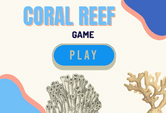Coral Reefs Game Quiz Online
This page features a Coral Reefs Game Quiz Online. It is an exercise for students studying science in 3rd, 4th, 5th, 6th to 8th grades. Learn about how important coral reefs are in creating the ecosystems in which several marine organisms thrive. This quiz contains 15 questions related to coral reefs as well as an interactive game component. You will earn a lot of points if you answer questions right. Click the start button to begin and look at the help section if you don't understand the game rules.

The Connection Between Ocean Acidification and the Coral Reef
What is the connection between ocean acidification and the Coral Reef?In this article, you'll learn the different types of coral and how they relate to the ocean. You'll also learn what causes ocean acidification and what to look for when visiting a coral reef. And, we'll discuss how the coral reef is preserved by humans. The first thing you need to know is that coral reefs play a major role in protecting the ocean environment.
the coral reef ecosystem
A coral reef is an ecosystem composed of millions of tiny, colorful polyps, or living organisms. Some are sessile, attaching themselves to corals while others are free-swimming, making the ecosystem an ideal place to find food and mates. Coral reefs are home to a diverse group of marine life, including sponges, starfish, crabs, and other invertebrates. The diversity of these creatures depends on the time of year and the location of the coral reef.
Corals have two basic types of bodies: hard corals and soft ones. Hard corals have rigid exoskeletons and soft corals lack one. Hard corals include brain corals, staghorn corals, and pillar corals. While the hard corals are relatively sturdy, the soft corals are extremely fragile and can break off and divide at will. Soft corals grow much slower, growing only centimeters per year but can be hundreds of meters thick. The Great Barrier Reef is the largest coral reef in the world, stretching over 3,000 kilometers along the northeast coast of Australia. A coral reef is the ideal home for thousands of species of sea life and has altered the landscape of Earth.
coral reef and ocean acidification
A new study details ocean acidification and how it affects coral reefs. Corals grow upwards and thicken their skeletons to protect themselves. With increasing ocean acidity, this process is hampered. As a result, coral skeletons become thinner, more fragile, and more prone to breakage. Ultimately, these effects are detrimental to the health of coral reefs.
The study is also the first to isolate the effects of ocean acidification on a natural coral reef. The researchers conducted the same experiment in 2008 with altered seawater chemistry to boost oyster production. Coral reefs are already facing a number of pressures, including rising ocean temperatures and nutrient and chemical pollution from rivers. They are also facing shortages of suitable habitat, a critical factor in coral growth. The problem is that coral reefs are naturally resilient to threats but can't regenerate or grow sturdy structures in an environment with so many stresses.
what causes ocean acidification
The ocean acidification process has profound effects on coral skeletal growth. It slows down coral growth and inhibits coralline algae from calcifying. However, some corals may benefit from this change. These creatures use carbon dioxide from the atmosphere to make calcium carbonate. This process is however being affected. But what causes ocean acidification? Learn more about the chemistry behind ocean acidification because it can affect many types of marine life.
CO2 is the most abundant greenhouse gas in the atmosphere. Since pre-industrial times, ocean pH has remained relatively constant. This delicate chemical balance has allowed marine life to evolve over millions of years. Since industrial times, the oceans have absorbed approximately 30 percent of carbon dioxide. This amount is absorbed by the ocean's surface layer, which is the top ten percent of water. Since the Industrial Revolution, the pH of the ocean has dropped 0.1 units. This is equivalent to a 26 percent acidification of the ocean's surface. It is estimated that reef development ceases when the pH falls below 7.8.
Types of coral reef
Coral reefs are made up of different types of animals and plant life. The shallow coral reefs are considered to be the most diverse ecosystem on Earth. Despite occupying less than 1% of the world's oceans, they are home to at least 25% of marine species. They are found mostly in tropical waters. Deep reefs are rare in colder climates. To learn more about the different types of coral reefs, read on!
The Elkhorn Coral is the most commonly observed type of coral. Its coloration resembles that of a bubble. It grows in caves and overhangs at depths of between three and 35 meters. It has a long, flexible tentacle that can be extended and viewed at night. The Tube Coral is another polyp stony coral that grows in deep waters. It has a yellow to lavender color.
Coral reef animals
Coral Reefs are living ecosystems in the ocean that are rich in coral polyps and other marine animals. These tiny animals live in large colonies, often in thousands of individuals, and are closely related to jellyfish and anemones. Coral reefs are home to up to 8 million species, many of which play important roles in the health of the entire reef system.
A healthy reef contains many different species, including fish, sponges, and starfish. They all need a hard surface to attach to and fight for their living space. Many of these animals require a hard surface to attach themselves to, including the larvae of the coral. As they grow into adult polyps, they start encircling other coral polyps and multiplying rapidly.
